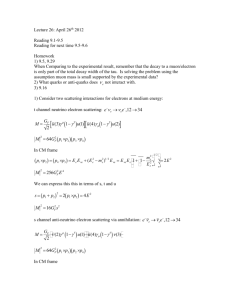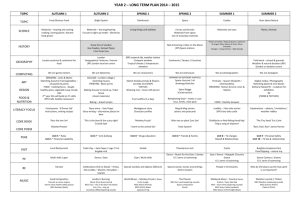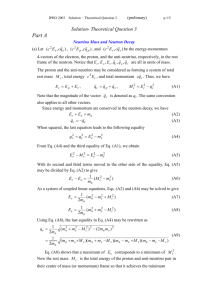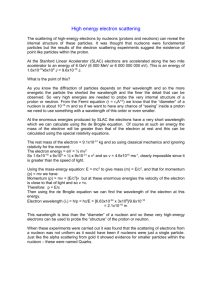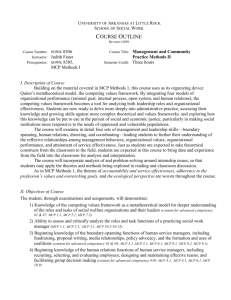Physics 535 lecture notes: - 24 Nov 27th, 2007 Homework due Next
advertisement
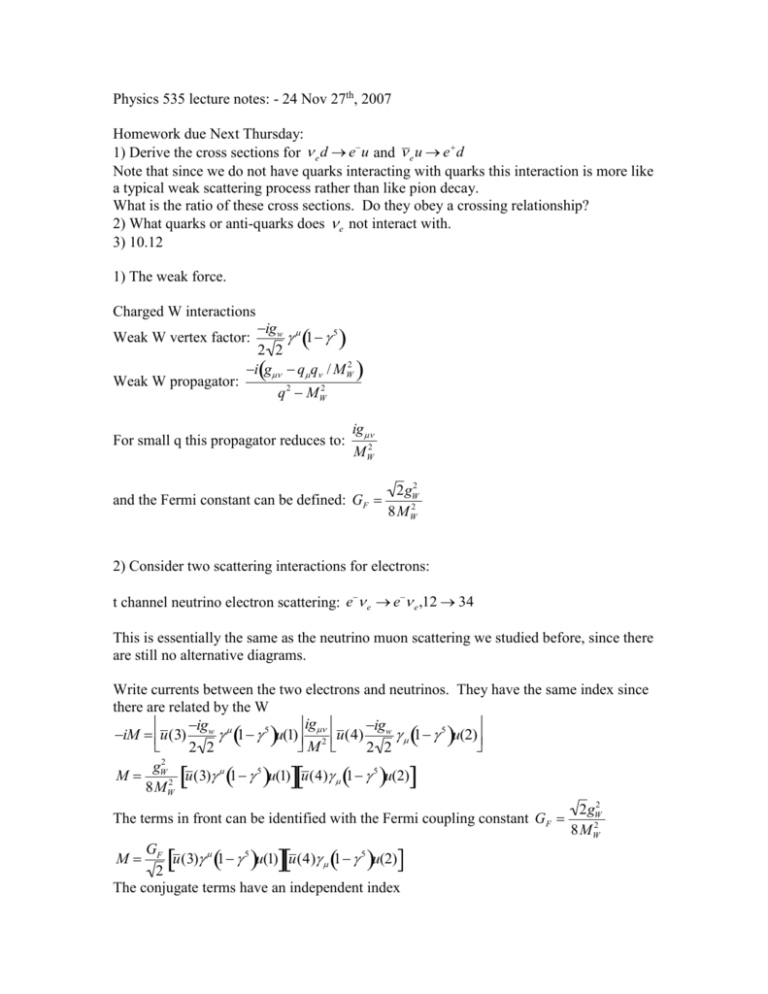
Physics 535 lecture notes: - 24 Nov 27th, 2007 Homework due Next Thursday: 1) Derive the cross sections for e d e u and e u e d Note that since we do not have quarks interacting with quarks this interaction is more like a typical weak scattering process rather than like pion decay. What is the ratio of these cross sections. Do they obey a crossing relationship? 2) What quarks or anti-quarks does e not interact with. 3) 10.12 1) The weak force. Charged W interactions igw 1 5 2 2 ig q q / MW2 Weak W vertex factor: Weak W propagator: q 2 MW2 ig For small q this propagator reduces to: 2 MW 2gW2 and the Fermi constant can be defined: GF 8M W2 2) Consider two scattering interactions for electrons: t channel neutrino electron scattering: e e e e ,12 34 This is essentially the same as the neutrino muon scattering we studied before, since there are still no alternative diagrams. Write currents between the two electrons and neutrinos. They have the same index since there are related by the W ig ig ig iM u (3) w 1 5 u(1) 2 u (4) w 1 5 u(2) M 2 2 2 2 2 g M W 2 u (3) 1 5 u(1) u (4) 1 5 u(2) 8MW 2gW2 The terms in front can be identified with the Fermi coupling constant GF 8M W2 G M F u (3) 1 5 u(1) u (4) 1 5 u(2) 2 The conjugate terms have an independent index * GF2 u (3) 1 5 u(1) u (3) 1 5 u(1) u (4) 1 5 u(2) u (4) 1 5 u(2) 2 GF2 2 M u (3) 1 5 u(1)u (1) 1 5 u(3) u (4) 1 5 u(2)u (2) 1 5 u (4) 2 M 2 Averaging over the spins of the initial electron, adds a factor of ½, and evaluating the traces GF2 Tr 1 5 p1 me 1 5 p3 me Tr 1 5 p2 1 5 p4 4 Terms to one order in the electron mass are zero because they have an odd number of gamma matrices. Terms to two orders cancel out. Evaluated the traces gives. M 2 M 64GF2 p1 p2 p3 p4 2 In CM frame 1/ 2 2 m e p1 p2 p4 p3 E e Ee (E m ) Ee Ee E e 1 1 2 2E 2 E e 1/ 2 2 m 2 2 1/ 2 e p1 p2 E e Ee (E e me ) Ee Ee E e 1 1 2 2E 2 E e 2 M 256GF2 E 4 2 e 2 1/ 2 e At high energy in CM frame we could also phrase this in terms of s, t and u s p1 p2 2 p1 p2 4 E 2 2 M 16GF2 s 2 2 s channel anti-neutrino electron scattering: ee ee ,12 34 Write currents between the two electrons and neutrinos. They have the same index since there are related by the W ig ig ig iM (2) w 1 5 u(1) 2 u (3) w 1 5 (4) M 2 2 2 2 2 g M W 2 (2) 1 5 u(1) u (3) 1 5 (4) 8MW G M F (2) 1 5 u(1) u (3) 1 5 (4) 2 The conjugate terms have an independent index * * GF2 (2) 1 5 u(1) (2) 1 5 u(1) u (3) 1 5 (4) u (3) 1 5 (4) 2 GF2 2 M (2) 1 5 u(1)u (1) 1 5 (2) u (4) 1 5 (3)(3) 1 5 u (4) 2 M 2 Averaging over the spins of the initial electron, adds a factor of ½, and evaluating the traces. Also ignoring the mass of the electron. M 2 GF2 Tr 1 5 p1 1 5 p2 Tr 1 5 p3 1 5 p4 4 M 64GF2 p1 p3 p2 p4 2 In CM frame p1 p3 p2 p4 E 2 1 cos M 64 E 4 1 cos 2 2 t p1 p3 2p1 p3 2 M 16GF2 t 2 2 In electron neutrino scattering s channel has the angular dependence and t is isotropic. Also the s channel diagram can be obtained from the t channel diagram by an s to t crossing. 3) Scattering cross sections M d 1 M pi 1 2 2 2 d 64 4 E p f 256 E 2 2 2 t channel neutrino electron scattering: e e e e ,12 34 M 256GF2 E 4 d 1 2 GF2 E 2 d 2 4 GF2 E 2 s channel anti-neutrino electron scattering: ee ee ,12 34 * d 1 2 GF2 E 2 1 cos 2 d 4 1 2 GF2 E 2 1 cos sin 2 2 4GF2 E 2 sin 2cos sin cos2 sin d 1 2 2 1 GF E cos cos2 cos3 2 3 4 2 2 GF E 3 There is also a difference in the total cross section! ee ee 1 e e e e 3 Why is anti-neutrino scattering one third as likely? We can make a helicity agreement. The backward scattering interaction for the anti-neutrino basically violates helicity conservation. This relationship would have been different if the W+ didn’t interact with neutrinos in a pure V-A way. Helicity conservation is an important factor in how neutrinos interact that has to be considered when detecting neutrinos and anti-neutrinos. 3) Pion decay ee Since the anti u and d quarks in the pion interact via the strong force it is incorrect to consider this as an annihilation diagram. However, it is instructive. du ee , 12 34 ig ig ig iM (2) w 1 5 u(1) 2 u (3) w 1 5 (4) M 2 2 2 2 2 G 2 M F (2) 1 5 u(1)u (1) (2) u (3) 1 5 (4)(4)1 5 u(3) 2 M 2 GF2 Tr 1 5 p1 md 1 5 p2 mu 1 5 p4 1 5 p3 2 Event though the mass terms will dominate they cancel along with any terms odd in a gamma matrix and we get. M 64GF2 p1 p4 p2 p3 2 In CM the quark momentums will be approximately 0 and we will gets terms with the quark mass times the energy of the outgoing particles. However, this is not quite a correct treatment. The distribution of momentums of the quarks, and thus the possible angular distributions of terms like p1 p4 , will be constrained by the strong force and we should treat them in a more generalized way. G 2 M F F u (3) 1 5 (4) 2 Where F will be a function of the pion and quark momentums p p1 p2 times a scalar function of p 2 , f p2 f m . G 2 M F F u (3) 1 5 (4) 2 2 2 G f 2 M F p p u (3) 1 5 (4)( 4) 1 5 u(3) 2 2 2 G f 2 M F p p Tr 1 5 p4 1 5 p3 2 2 2 G f 2 M F p p 8p4 p3 p3 p4 g p3 p4 8ip1 p3 2 2 M 4GF2 f 2 2p p3 p p4 p2 p3 p4 using p p1 p2 p3 p4 p p3 p3 p4 p3 me2 p3 p4 p p4 p3 p4 p4 p3 p4 p 2 p3 p4 p32 p42 2p3 p4 me2 2p3 p4 m2 2p3 p4 m2 me2 2 1 1 1 1 1 1 2 M 4GF2 f 2 2me2 m2 me2 m2 me2 m2 m2 me2 2 2 2 2 2 2 M 2GF2 f 2 m2 me2 m2 me2 m2 m2 me2 2 M 2GF2 f 2 me2 m2 me2 2 The decay width is pf pf 1 m2 me2 2m M 2 8m Where using homework 3.16 (mA,0,0,0) = (EB + EC,0,0,0) (mA,0,0,0) = (EB + (pB2 + mC2)1/2,0,0,0) (mA,0,0,0) = (EB + (EB2 - mB2 + mC2)1/2,0,0,0) m A = EB + (EB2 - mB2 + mC2)1/2 (m A - EB)2 = EB2 - mB2 + mC2 m A2 -2 m A EB + EB2 = EB2 - mB2 + mC2 EB = (m A2 + mB2 - mC2)/2 m A 2 1 GF2 f 2 me2 2 2 2 2 2 2 2 2 m m 2G f m m m m me2 e F e e 3 3 16m 8m If we compare the decay width to muons and electrons ee me2 m2 me2 2 2 m 2 m2 m2 Again we can make a helicity argument. The electron or muon is forced to be in the wrong helicity state which can happen more often the muon.
